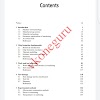Carbon And Its Compound
The atomic number of carbons is 6. Its electronic configuration is 2, 4. It requires 4 electrons to
achieve the inert gas electronic configuration. It can achieve noble gas configuration, If it were to
lose or gain 4 electrons.
It could gain four electrons forming C-4
anion. But it would be difficult for the nucleus with six
protons to hold on to ten electrons.
It could lose four electrons forming C+4 cations. But it requires a large amount of energy to
remove four electrons.
Thus, carbon overcomes this problem by sharing of its valence electrons with other carbon
atoms or with atoms of other elements.
Covalent bond
The bond formed by mutual sharing of electron pairs between two atoms in a molecule is known
as Covalent Bond.
Types of Covalent Bond:
Single Covalent Bond: When a single pair of electrons are shared between two atoms in a
molecule. For example; F
2
, Cl
2
, H2
, HCl , H2O, CH4, NH3etc.
Double Covalent Bond: When two pairs of electrons are shared between two atoms in a molecule.
For example; O
2
, CO
2
etc.
Triple Covalent Bond: When three pairs of electrons are shared between two atoms in a molecule.
For example; N
2
etc.
ALLOTROPY
Allotropy is defined as the property by which an element can exist in more than one form that are
physically different but chemically similar.
Allotropes of carbon
Carbon exists in three allotropic forms. They are crystalline form (diamond and graphite), amorphous
form (coke,charcoal) and fullerene.
In diamond each carbon atom is bonded to four other carbon atoms forming a rigid three
dimensional structure , accounting for it’s hardness and rigidity.
In graphite each carbon atom is bonded to three other carbon atoms in the same plane giving
hexagonal layers held together by weak vander Waals forces accounting for softness.
Fullerenes form another type of carbon allotropes. The first one was identified to contain 60 carbon
atoms in the shape of a football. (C-60).
Versatile Nature of Carbon: -
The existence of a large number of organic compounds is due to the following nature of carbon-
Catenation
Tetravalent nature.
Catenation
The self-linking property of an element mainly carbon atom through covalent bonds to form long
straight, branched chains and rings of different sizes is called catenation.
This property is due to
Click here to download 👉10th SCIENCE NCERT Books Short Notes
For full TEST SERIES ,HAND WRITTEN NOTES , IMP. BOOKS & PDF For GME you have to pay a little bit.
Download the app Now STUDY
MANIA
If you are not able to view these PDF file.. please give permission to" Request to access the file " and wait for some time and then Retry once... Or you may also comment " open #topice " in comment section of blog .
For more details regarding any issue you may mail us on vkoneguru@gmail.com
We Got Great Search Results For Your Query: Mechanical Engineer Degree. Click HereSTUDY materials for Gate, IES, UPSE &any university exam and Find Everything You Need.
Comments for any books with subject name and writter name...
We try to give you best..
For regular updates you must verify your email id...
Thanks
Please subscribe and follow us vkoneguru
You can search on Google also vkoneguru and follow us..








0 Comments